Pilot whales are members of the Delphinidae family that get their name from the unproven belief that a single member of the pod leads the rest and that they’ll follow that individual even if it means certain death, which is supposed to explain why pilot whales strand en mass. Indeed, pilot whales are among the most likely cetacean species to become stranded. Pilot whales are also commonly called blackfish and potheads, the latter due to their bulbous head shape and not their recreational habits.
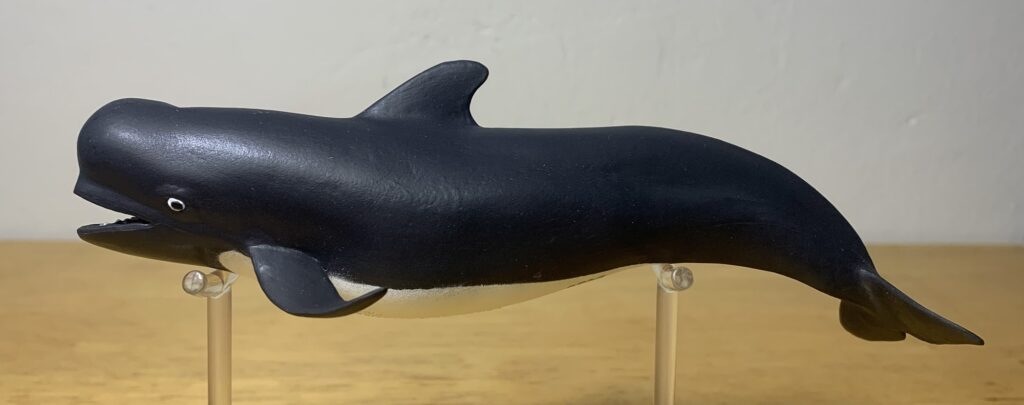

Two species of pilot whale have been described, the long-finned (Globicephala melas) and the short-finned (G. macrorhynchus). The genus has a nearly world-wide distribution, but long-finned pilot whales prefer colder water while short-find pilot whales prefer tropical and sub-tropical seas. Pilot whales live in pods of 15-50 individuals, but groups can be larger in some instances. Squids make up the bulk of their diet, but they’ll also feed on octopuses and fish on occasion.
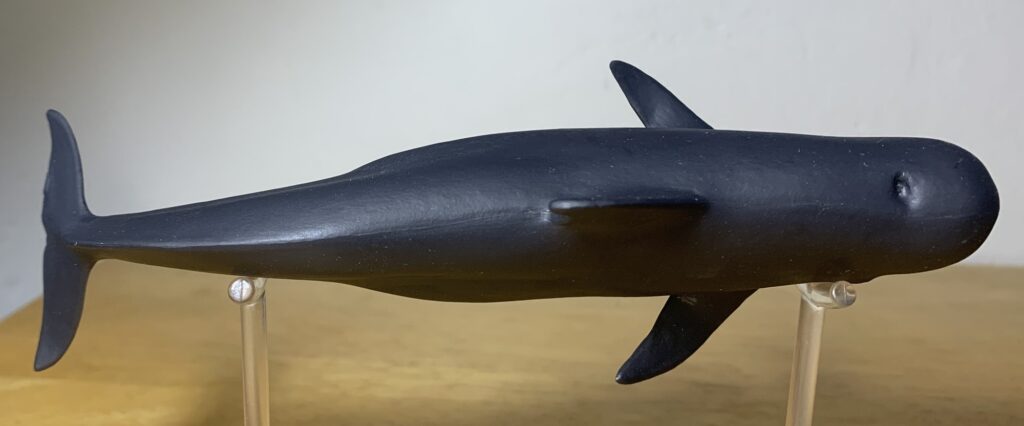
A handful of pilot whale figures exist and nearly all of them represent the short-finned pilot whale, including the subject of today’s review, the 2014 Safari pilot whale. The Safari pilot whale measures 6.5” (16.51 cm) long while the actual short-finned pilot whale measures between 17-24’ (5.1-7.2 meters). This puts the figure in the 1/31-1/44 scale range. The figure is sculpted in a gently undulating swimming motion.

The body of the figure is appropriately long and robust with a bulbous melon protruding beyond the front of the short beak. The melons are generally larger on older males. The mouth on the figure is straight edged while in the actual species is slants upwards toward the eye, like a smile. The open mouth displays some finely sculpted dentition.
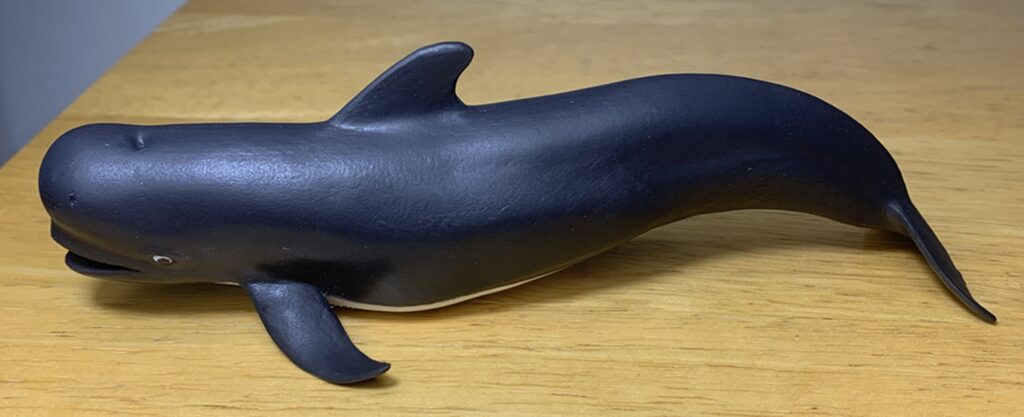
The dorsal fin is positioned far-forward, has a long base, and is strongly curved. This is all accurate but on the figure it’s a bit conservative in size and shape as the dorsal fin can look positively absurd in some individuals. The tail stock is deep and laterally compressed and the fluke has pointed tips but again, the depth of the tail stock is on the conservative side. These conservative proportions seem to suggest that this individual represents a female, even though it is missing mammary slits. There also aren’t any sculpted ears while CollectA’s figure has them.

The proportionally short flippers are what suggests that this figure represents the short-finned pilot whale but in reality, there is a degree of overlap in the flipper size of the two species, and flipper length is not always a reliable way to identify pilot whales. Their shape is also a better match for the short-finned though, since their curvature is less extreme than that generally seen in the long-finned.
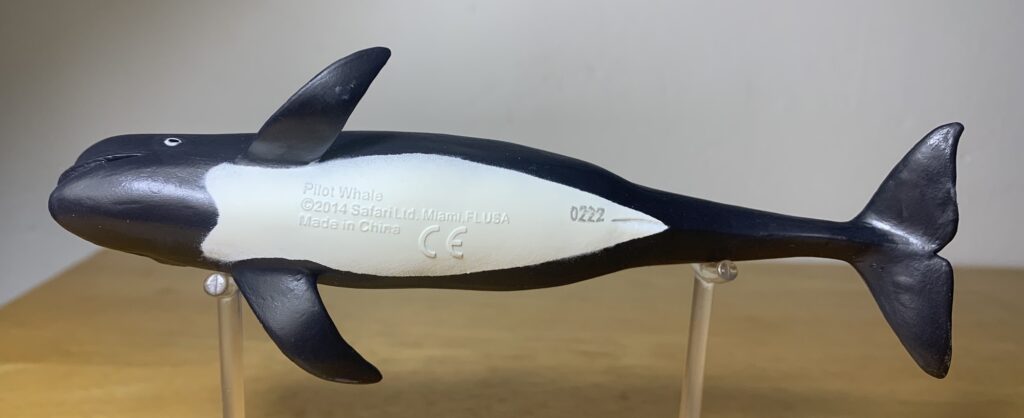
The figure is entirely black except for the white patch on the underside that extends from the throat to the genital slit. The white throat patch would ideally be gray, anchor shaped, and connected to a separate white patch over the genital slit via a thin stripe. Ideally there would also be a pale gray saddle patch behind the dorsal fin, and a blaze marking extending upward from behind the eyes. These features can be variable and/or hard to discern but I think it would have behooved Safari to have added them. CollectA’s pilot whale illustrates these features and is unarguably a better figure for it. Also, Safari has the black eye painted over a white spot that shouldn’t be there. It would have been better to just paint the black eye over the black body.
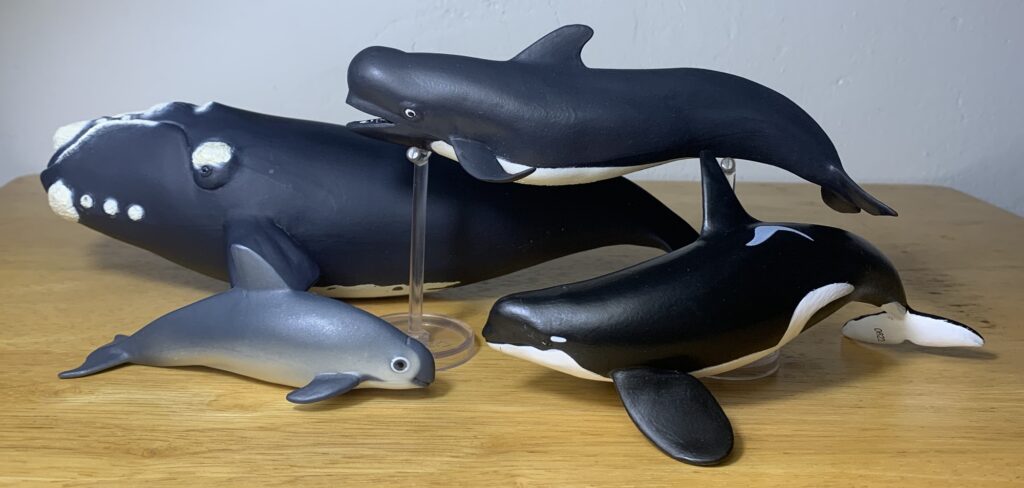
The Safari pilot whale gets the broad strokes of the genus correct but misses the mark on subtle features. Unfortunately, this means that as far as pilot whales go, the better option comes from CollectA. That said, I have seen some bemoan the extreme lateral bend of the body on CollectA’s, so Safari has them beat on posture. Maybe we’re in need of a new pilot whale that’s better than either of them! I went with Safari’s figure because it was on sale at $4.19 (it’s still being sold for that price on Safari’s site), making it half the price of CollectA’s. Also, it needed a review, and I was happy to supply it with one. It’s not a perfect figure but it’s good enough.
Disclaimer: links to Ebay and Amazon on the AnimalToyBlog are affiliate links, so we make a small commission if you use them. Thanks for supporting us!




I have this figure to represent this species. I can’t remember why I picked it over CollectA (may have just been availability at the time), but I have no regrets. I am happy with it (cetaceans are low on my priority radar, so I tend to be less picky with them anyway).
I’m pleased with it too but like I hinted at in the review, if someone made a pilot whale better than this or CollectA’s I would consider replacing it. Ideally we’ll get a long-finned pilot whale before another short-finned though.